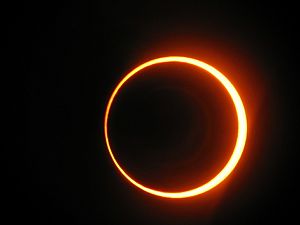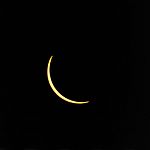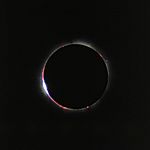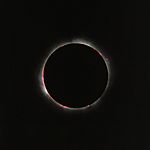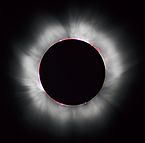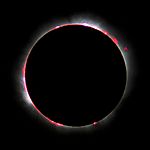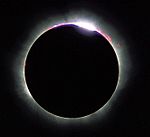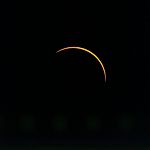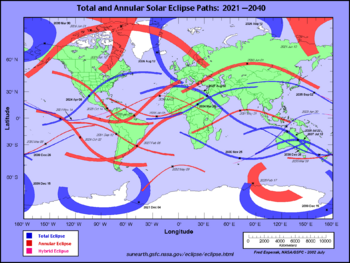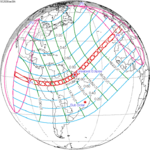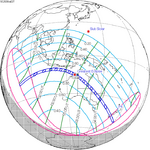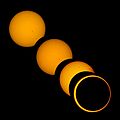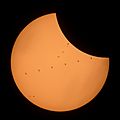Solar eclipse facts for kids
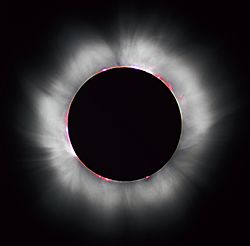
When seen from Earth, a solar eclipse (ee klips') happens when the Moon passes between the Earth and the Sun. This makes the Moon fully or partially (partly) cover the sun. Solar eclipses can only happen during a new moon. Every year about two solar eclipses occur. Sometimes there are even five solar eclipses in a year. However, only two of these can be total solar eclipses, and they are quite uncommon.
Eclipses are total only in a narrow track along the Earth, and only for a few minutes. Outside this path, all eclipses are partial, and places far from the track get no eclipse at all. The track can be predicted many years before it happens. Many people who are sometimes called "eclipse chasers" or "umbraphiles" (the moon's shadow is called an umbra) travel to faraway places to see solar eclipses. After the solar eclipse on August 11, 1999, in Europe, people began to show more interest in solar eclipses. On October 3, 2005, there was another solar eclipse, and unusually many people came to see it.
Between two and five solar eclipses occur every year, with at least one per eclipse season. Since the Gregorian calendar was instituted in 1582, years that have had five solar eclipses were 1693, 1758, 1805, 1823, 1870, and 1935. The next occurrence will be 2206. On average, there are about 240 solar eclipses each century.
A total solar eclipse is a natural phenomenon (event). Long ago, solar eclipses were thought to happen because of something supernatural or as a sign that something bad was going to happen. This is still believed in some cultures today. A total solar eclipse can frighten people who do not know what it means, because the Sun seems to disappear during the day and the sky turns dark in just a few minutes.
Solar eclipses happen somewhere on Earth almost every year, and very similar solar eclipses happen every 18 years, 11.3 days. This period is called the Saros cycle.
Contents
Historical eclipses
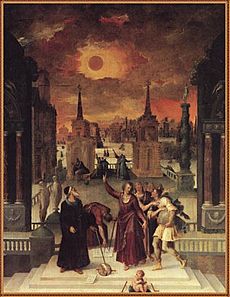
The oldest recorded solar eclipse was recorded on a clay tablet found at Ugarit, in modern Syria, with two plausible dates usually cited: 3 May 1375 BC or 5 March 1223 BC, the latter being favored by most recent authors on the topic. A solar eclipse of June 15, 763 BC mentioned in an Assyrian text is important for the chronology of the ancient Near East. There have been other claims to date earlier eclipses. The legendary Chinese king Zhong Kang supposedly beheaded two astronomers, Hsi and Ho, who failed to predict an eclipse 4,000 years ago. Perhaps the earliest still-unproven claim is that of archaeologist Bruce Masse, who putatively links an eclipse that occurred on May 10, 2807, BC with a possible meteor impact in the Indian Ocean on the basis of several ancient flood myths that mention a total solar eclipse. The earliest preserved depiction of a partial solar eclipse from 1143 BCE might be the one in tomb KV9 of Ramses V and Ramses VI.
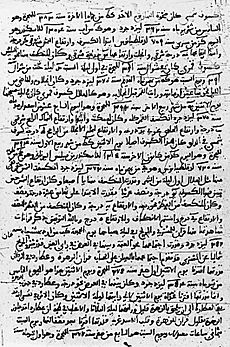
Eclipses have been interpreted as omens, or portents. The ancient Greek historian Herodotus wrote that Thales of Miletus predicted an eclipse that occurred during a battle between the Medes and the Lydians. Both sides put down their weapons and declared peace as a result of the eclipse. The exact eclipse involved remains uncertain, although the issue has been studied by hundreds of ancient and modern authorities. One likely candidate took place on May 28, 585 BC, probably near the Halys river in Asia Minor. An eclipse recorded by Herodotus before Xerxes departed for his expedition against Greece, which is traditionally dated to 480 BC, was matched by John Russell Hind to an annular eclipse of the Sun at Sardis on February 17, 478 BC. Alternatively, a partial eclipse was visible from Persia on October 2, 480 BC. Herodotus also reports a solar eclipse at Sparta during the Second Persian invasion of Greece. The date of the eclipse (August 1, 477 BC) does not match exactly the conventional dates for the invasion accepted by historians.
Chinese records of eclipses begin at around 720 BC. The 4th century BC astronomer Shi Shen described the prediction of eclipses by using the relative positions of the Moon and Sun.
Attempts have been made to establish the exact date of Good Friday by assuming that the darkness described at Jesus's crucifixion was a solar eclipse. This research has not yielded conclusive results, and Good Friday is recorded as being at Passover, which is held at the time of a full moon. Further, the darkness lasted from the sixth hour to the ninth, or three hours, which is much, much longer than the eight-minute upper limit for any solar eclipse's totality. Contemporary chronicles wrote about an eclipse at the beginning of May 664 that coincided with the beginning of the plague of 664 in the British isles. In the Western hemisphere, there are few reliable records of eclipses before AD 800, until the advent of Arab and monastic observations in the early medieval period.
Types
There are four different types of solar eclipses:
- A total eclipse is when the Sun is completely hidden behind the Moon. The dark shadow of the Moon covers the very bright surface of the Sun. This makes the corona easier to see.
- An annular eclipse is when the Sun is directly behind the moon, but it looks like the Moon is smaller. This makes the Sun appear as a very bright ring or annulus around the shape of the Moon.
- A hybrid eclipse (also called annular/total eclipse) is when it looks like a total eclipse in some parts of the Earth, and an annular eclipse in other parts. Hybrid eclipses do not happen as often as other eclipses.
- A partial eclipse is when the moon is not exactly between the Sun and Earth, so it does not hide the Sun completely. This can usually be seen from a large part of the Earth.
The Sun's distance from the Earth is about 400 times the Moon's distance, and the Sun's diameter is about 400 times as big as the Moon's. This is why the Sun and Moon seem to be about the same size from Earth.
Looking at a solar eclipse
Looking directly at the bright surface of the Sun itself can hurt the retina of the eye greatly because of the radiation that comes from the Sun. It can even blind people. The retina does not feel pain, so damage may not be felt for hours.
The Sun is usually so bright that it is hard to look at it directly. However, when the Sun is covered in an eclipse, it is easier to look at it. Looking at the Sun during an eclipse is equally dangerous, except in the very short time when the Sun's surface is completely covered. Looking at the Sun's surface through binoculars, a telescope, or even a camera is extremely dangerous and can damage the eye in less than a second.
Looking at the Sun without an eclipse does not usually hurt the eye very greatly, because the pupil of the eye closes down and makes everything darker. If the Sun is almost completely covered, the pupil opens because there is not as much light. However, the parts of the Sun that can be seen are still equally bright, and can hurt the eye very much.
Eclipse chasing
A dedicated group of eclipse chasers have pursued the observation of solar eclipses when they occur around Earth. A person who chases eclipses is known as an umbraphile, meaning shadow lover. Umbraphiles travel for eclipses and use various tools to help view the sun including solar viewing glasses, also known as eclipse glasses, as well as telescopes.
Photography
Photographing an eclipse is possible with fairly common camera equipment. In order for the disk of the Sun/Moon to be easily visible, a fairly high magnification long focus lens is needed (at least 200 mm for a 35 mm camera), and for the disk to fill most of the frame, a longer lens is needed (over 500 mm). As with viewing the Sun directly, looking at it through the optical viewfinder of a camera can produce damage to the retina, so care is recommended. Solar filters are required for digital photography even if an optical viewfinder is not used. Using a camera's live view feature or an electronic viewfinder is safe for the human eye, but the Sun's rays could potentially irreparably damage digital image sensors unless the lens is covered by a properly designed solar filter.
Recent and forthcoming solar eclipses
Eclipses occur only in the eclipse season, when the Sun is close to either the ascending or descending node of the Moon. Each eclipse is separated by one, five or six lunations (synodic months), and the midpoint of each season is separated by 173.3 days, which is the mean time for the Sun to travel from one node to the next. The period is a little less than half a calendar year because the lunar nodes slowly regress. Because 223 synodic months is roughly equal to 239 anomalistic months and 242 draconic months, eclipses with similar geometry recur 223 synodic months (about 6,585.3 days) apart. This period (18 years 11.3 days) is a saros. Because 223 synodic months is not identical to 239 anomalistic months or 242 draconic months, saros cycles do not endlessly repeat. Each cycle begins with the Moon's shadow crossing Earth near the north or south pole, and subsequent events progress toward the other pole until the Moon's shadow misses Earth and the series ends. Saros cycles are numbered; currently, cycles 117 to 156 are active.
2022–2025
This eclipse is a member of a semester series. An eclipse in a semester series of solar eclipses repeats approximately every 177 days and 4 hours (a semester) at alternating nodes of the Moon's orbit.
| Ascending node | Descending node | |||||
|---|---|---|---|---|---|---|
| Saros | Map | Gamma | Saros | Map | Gamma | |
119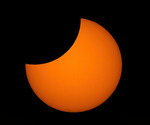 Partial from CTIO, Chile |
2022 April 30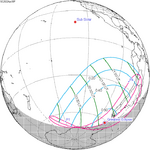 Partial |
−1.19008 | 124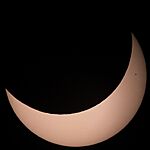 Partial from Saratov, Russia |
2022 October 25 Partial |
1.07014 | |
129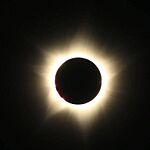 Total from East Timor |
2023 April 20 Hybrid |
−0.39515 | 134 Annular from Campeche, Mexico |
2023 October 14 Annular |
0.37534 | |
| 139 | 2024 April 8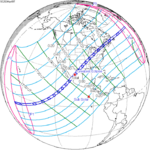 Total |
0.34314 | 144 | 2024 October 2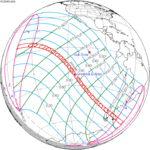 Annular |
−0.35087 | |
| 149 | 2025 March 29 Partial |
1.04053 | 154 | 2025 September 21 Partial |
−1.06509 | |
2026–2029
This eclipse is a member of a semester series. An eclipse in a semester series of solar eclipses repeats approximately every 177 days and 4 hours (a semester) at alternating nodes of the Moon's orbit.
Partial solar eclipses on June 12, 2029, and December 5, 2029, occur in the next lunar year eclipse set.
Images for kids
-
Total solar eclipse paths: 1001–2000, showing that total solar eclipses occur almost everywhere on Earth. This image was merged from 50 separate images from NASA.
-
Erhard Weigel, predicted course of moon shadow on 12 August 1654 (O.S. 2 August)
-
The progression of a solar eclipse on August 1, 2008 in Novosibirsk, Russia. All times UTC (local time was UTC+7). The time span between shots is three minutes.
-
Eddington's original photograph of the 1919 eclipse, which provided evidence for Einstein's theory of general relativity.
See also
 In Spanish: Eclipse solar para niños
In Spanish: Eclipse solar para niños


